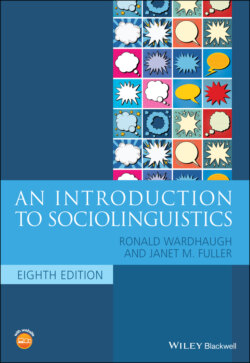Читать книгу An Introduction to Sociolinguistics - Ronald Wardhaugh, Janet M. Fuller - Страница 84
Implicit association task (IAT)
ОглавлениеThe IAT is a method which has been adapted from social psychology and is designed to measure the strength of associations between particular concepts and categories. The task presents questions in ‘blocks,’ that is, groups of questions where the left and right buttons are used to categorize stimuli as, for example, good/bad, or insects/flowers. The ease, and thus the speed, of the categorization indicates to what extent the research participant finds the concepts congruent; thus the data makes use of reaction times of responses to show implicit associations. Campbell‐Kibler (2012, 755) provides this example:
Consider the task of sorting items into the two dichotomies insects/flowers and good/bad. Through the experimental procedure, some of the blocks involve the participant pressing the left hand button to select insects and bad and the right hand button to select flowers and good. In other blocks, they are asked to press the left hand button to select insects and good and the right hand button to select flowers and bad. To the extent that the participant prefers flowers over insects, flowers and good will resolve itself into a more coherent shared category, as will insects and bad, compared to the alternate arrangement. These shared categories allow for easier, and therefore faster (and less error‐prone) responses in that condition. The difference in response times across the two combinations thus can be taken to represent a measure of implicit connection across the two dichotomies.
The stimuli for this task can vary and may include sound clips, as is relevant for sociolinguistic studies, and may be matched to categories or judgments such as ‘I like’ or ‘I don’t like’ (Rosseel et al. 2018). Thus this task can measure broad attitudes to varieties, or see how the linguistic stimuli correlate with other features such as region or occupation of the speaker.
Research within this paradigm can provide insights into implicit biases which research participants are unlikely to admit to, or even be aware of. For example, Pantos and Perkins (2013) did a task which showed that native speakers of English were aligned with ‘good’ while speakers of English with a foreign accent were aligned with ‘bad,’ although the research participants reported no bias when asked about their attitudes.
Other associations were also measured by Campbell‐Kibler (2012) in research among US university students. This research showed associations between a particular variable and social factors. One variable examined was ING, that is, the variation in realization of the ‐ing ending on English words as (for example) being versus bein’. The results showed that the ‐ing form was associated with Northern states, white‐collar professions, and network news anchors, while the ‐in’ variable was associated with Southern states, blue‐collar professions, and country singers. Further experiments also showed that this task could also examine associations between different linguistic variants. For example, the ‐in’ variant was also associated with /ai/ monophthongization, a stereotypical Southern dialect feature. (As we will discuss further in chapter 5, the ING variable is one which has been studied extensively.) Thus this task is promising for not just studying language attitudes, but sociolinguistic meaning of linguistic features more generally.
Given the clear patterns of attitudes in many of these studies, we must consider the consequences of such evaluative reactions to certain ways of speaking. While this topic has not been the focus of attitudes studies to date, a 2019 special issue in the Journal of Language and Discrimination centers on this theme (see Baumgartner and Du Bois 2019, in Further Reading). We will continue to address this issue in this text, with special focus on discrimination and social justice in Part IV.
